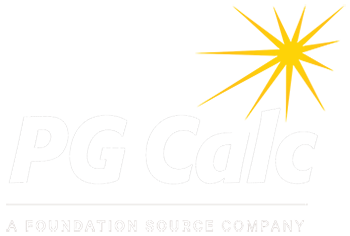Featured Articles
PG Calc publishes monthly articles on the latest topics in planned giving.
Non-Deductible Gifts That Save Taxes Anyway
-Gift planners have become adept at explaining the tax advantages of Qualified Charitable Distributions, even though there is no income tax charitable deduction involved. But are there advantages for other non-deductible charitable contributions?
Perhaps surprisingly, the answer is yes! Especially these days, with fewer taxpayers itemizing than ever, it is helpful to be prepared to discuss non-deductible contributions with prospective donors.
In this article, we will review three options for charitable gift planning without an income tax charitable deduction:
- Contributions of appreciated property from non-itemizers,
- Gifts of services, and
- Contributions of ordinary income property.
It’s All Good, But Can You See the Future?
-Projecting Remainder Amounts for Bequest Gifts in PG Calc’s Bequest Manager Application
A healthy and robust planned giving program typically includes a broad array of split-interest gift arrangements – certainly the familiar life income gifts – charitable gift annuities, charitable remainder trusts, (perhaps) a pooled income fund, and occasionally even a retained life estate or two – but the largest portions of most programs invariably consist of bequests and other gifts triggered upon the deaths of the donors. Whatever the variety in each organization’s program, the general idea is that the benefits to the charity will come at a later point in time. This means we are put in the position of expecting charitable gifts to be realized in the future, and we are presented with the challenge of how to estimate the values of those gifts over time.
PG Calc’s Bequest Manager application is a subset of the company’s venerable GiftWrap system, which is an industry-leading product specifically designed and built for the ongoing management and administration of planned gifts. Bequest Manager allows for booking donors’ intended bequests in a preliminary status as soon as each individual provides notice to the charity.
ACE Act Proposes Important Changes in DAF Rules
-No doubt, you have heard about looming changes threatening the long-established rules governing donor advised funds (DAFs). Some commentators are sounding the alarm. The Philanthropy Roundtable says the changes “would stifle charitable giving, harming those in need.” Others welcome the effort to free up charitable dollars they believe have been squirrelled away for far too long. We will leave the Wagnerian sturm und drang to others, but it is important to understand these proposals and what may be coming our way.
On June 9, 2021, Senator Angus King (I-ME) introduced Senate Bill 1981, the Accelerating Charitable Efforts Act (the “ACE Act”) with Senator Charles Grassley (R-IA) as a co-sponsor. The bill was referred to the Committee on Finance. As of this writing, there are no additional co-sponsors and no companion legislation in the House. Although legislative prognosticators give the ACE Act only a 1% chance of becoming law in its current form, parts of it could find their way into other legislation. In addition, the ACE Act is heating up long-simmering debates about donor advised funds and private foundations.
Although the ACE Act includes some significant changes to the private foundation rules, donor advised funds are the primary focus – some will say “target” – of the bill. Following is a summary of major provisions of the ACE Act that apply to donor advised funds.
A Look at the New CASE Global Reporting Standards
The Council for the Advancement and Support of Education (CASE) has released its “Global Reporting Standards, 1st Edition.” The vision for the Standards is audacious: “the first truly worldwide standards for advancement in education.” True to its title, among the book’s 350+ pages are supplemental chapters that provide specific guidance for counting charitable gifts in six different countries around the globe.
Although the primary focus is to articulate standards for the counting and recognition of all types of charitable contributions that will facilitate comparisons among educational institutions worldwide, the Standards also cover a broad range of issues beyond counting and recognition. There are extensive sections on ethics and standards of practice for advancement professionals, as well as guidance for navigating issues involving donor control and the moral thickets that can arise when a donor’s nefarious past comes to light.
Even if your organization is not involved in the education sector, it behooves you to be familiar with the CASE Standards.
This Could be the Year of the Charitable Lead Trust
-The combination of extremely low monthly IRS discount rates, a stock market at or near record highs, and the possibility of increased estate taxation before the year is over creates ideal conditions for turning lead trust prospects into lead trust donors. Take advantage of the moment! Completing even a handful of lead trusts could make a big difference to the finances of your organization.
Non-grantor lead trusts offer wealthy individuals the opportunity to pass assets to their heirs at substantial tax savings while providing immediate benefits to one or more charities they care about. Grantor lead trusts offer a wider range of donors a tax-efficient way to fulfill multi-year pledges or to offset an income windfall while fulfilling their charitable wishes.
Overcoming Challenges of Endowment Fundraising
-You work at a nonprofit that has an endowment. You know you should be part of the solution to grow it. Or perhaps you work at a nonprofit that doesn’t have an endowment, but you think it’s a missed opportunity that you want to rectify. What’s holding you back? What institutional decisions are making your job harder? How can you get on with the business of closing transformational gifts to your charity?
The intention here is to demystify endowments and set out some best practices for fundraising for them. This article is primarily aimed at fundraisers but does contain ideas that will require coordination and implementation from other areas of your charity.
Using a CRT or CGA to Stretch Payments From a Retirement Plan
-In this article, Bill Laskin, PG Calc's Vice President of Product Management, explores the tax implications of the SECURE Act for IRAs and how that could impact gift planning.
IRS statistics indicate traditional IRAs held nearly $8 trillion in assets at the end of 2018, the latest year for which data is available. That is a huge potential source of charitable gifts. Any change that might increase the likelihood of gifts of IRA assets is enough to get gift planners excited, and rightly so.
The SECURE Act that was signed into law at the end of 2019 contained several provisions that drew the attention of gift planners. One provision of the Act was elimination of the so-called “stretch” IRA for most non-spouses.
The SECURE Act significantly limited who can stretch payments from an inherited IRA over their life expectancy. Gift planners recognized that for charitably minded IRA owners, the elimination of the “stretch” IRA created an additional incentive to designate what is left in their IRA to one or more charities and use other funds to benefit their heirs.
2020: It Was the Best – and Worst – of Times
-As Charles Dickens wrote in his A Tale of Two Cities: “It was the best of times, it was the worst of times, it was the age of wisdom, it was the age of foolishness, it was the epoch of belief, it was the epoch of incredulity, it was the season of Light, it was the season of Darkness.” Those words were written in 1859, but they could have been written yesterday.
How do we even begin to describe the year that was 2020? It was a year of so many extremes – a once-in-a-century pandemic, the most widely contested elections in U.S. history, unprecedented economic collapse, historic unemployment, tsunamis of misinformation and disinformation, and truly unimaginable levels of mistrust, suffering, and despair in the souls of people everywhere.
Change Is Here
-As of the writing of this article, the inauguration of Joseph R. Biden, Jr. as the 46th President of the United States is just days away. Although past changes in the balance of political power have had little impact on overall charitable giving, we know that when donors experience uncertainty they tend to postpone and delay their giving decisions. This is a natural reaction: charitable giving is optional and, faced with uncertainty, the rational choice is to slow down or defer giving until the future becomes clearer.
Changes in tax law can create new and different gift opportunities. Gift planners will need to watch carefully and be prepared to react strategically to changing circumstances. What concerns might surface among donors? Could potential changes affect donors’ gift plans? How might we anticipate and address them? In this article we begin with a review of some concerns that are likely to be on donors’ minds with respect to charitable giving followed by a discussion of some of the essential processes by which Washington works.
Tax Implications of the Next President
-PG Calc speculates and offers commentary about impending changes to Federal tax policy and the possible impacts on charitable giving. However, written on the eve of America’s transition to the Biden/Harris administration and the beginning of the 117th Congress, there’s a good chance that parts of it will pass into the category of "things we know for sure that just ain't so."

